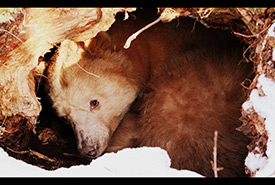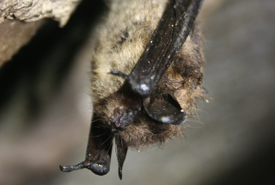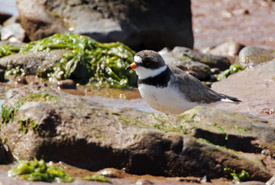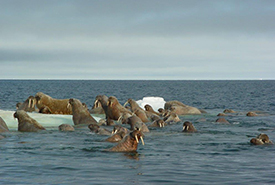Sleepflying is the new sleepwalking: Species and their sleeping patterns

Grizzly bear cub denning (Photo by Sarah Whynne CC BY-NC 2.0)
Sleep. We all need it, and we all want more of it. Whether you’re an early riser or a night owl, sleep is an important part of human development and health. Sleep helps heal and repair your heart and blood vessels, and lack of sleep can increase your risk of heart disease, diabetes, stroke and high-blood pressure. Getting enough sleep has also been tied to better weight management.
So how does sleep affect other animals? Well, like humans, it helps them restore and conserve energy. We see this in hibernating and brumating species, such as bears, snakes and turtles. When the weather gets cold and food sources dwindle, sleep helps species maintain enough energy and fat to survive the winter.
The amount that mammals sleep is often tied to how large they are. This is because smaller mammals have higher metabolic rates and body temperatures. As a result, they burn more energy, more quickly. Rodent species can spend up to 18 hours a day sleeping, while larger mammals, such as elephants, require only around three hours of sleep daily.
Related blog posts
One of nature’s sleepiest species is little brown myotis. One of Canada’s 18 bat species, little brown myotis — also known as little brown bat — measures only eight to 10 centimetres in length and weighs just five to 14 grams. Like most bat species, little brown myotis is nocturnal, typically roosting in trees, caves and buildings during the day.

Little brown bat (Photo by Ann Froschauer, USFWS/Wikimedia Commons)
Throughout summer, it often raises its offspring in tree cavities, attics, abandoned buildings and barns. When summer ends, bats migrate up to 1,000 kilometres from their summer roosts to their winter ones, where they hibernate from October or November to March or April. Hibernation most often takes place in humid caves or abandoned mines with above-freezing temperatures. Undisturbed, little brown myotis can sleep for up to nearly 20 hours per day.
Bats, including little brown myotis, sleep upside down. This is because their wings are not strong enough to lift their bodies into flight from the ground. They must use gravity to drop into flight.

Semipalmated plover, Johnson's Mills, NB (Photo by Mike Dembeck)
Migratory birds are another flying species that can travel long distances during migration. From July to September, semipalmated sandpipers migrate through Canada and the eastern United States, to make the 10,000-kilometre flight to their wintering grounds along the east and west coasts of South America. Journeys like these small but mighty birds take can last for days on end, so when do they sleep?
It is believed that migratory birds have the ability to sleep while in flight. These species are called unihemispheric sleepers. They are able to sleep by gliding and soaring through the air, but each half of their brain alternates sleeping (i.e., one half of their brain sleeps while the other half remains awake). This is also how they are also able to eat while flying.

Walruses, Lancaster Sound, Nunavut (Photo by Mario Cyr)
Unihemispheric sleepers also include whales and walruses. Species such as Atlantic walrus can sleep while floating in the water, but they are also known to take long snoozes of up to 19 hours on land. They also have the ability to forgo sleep for anywhere from 40 to more than 80 hours.
It is evident that sleep is important for all species. Whether it’s upside down, in the air, under water or in a comfortable bed, getting enough shut-eye is essential to both human and other animal development and health.


